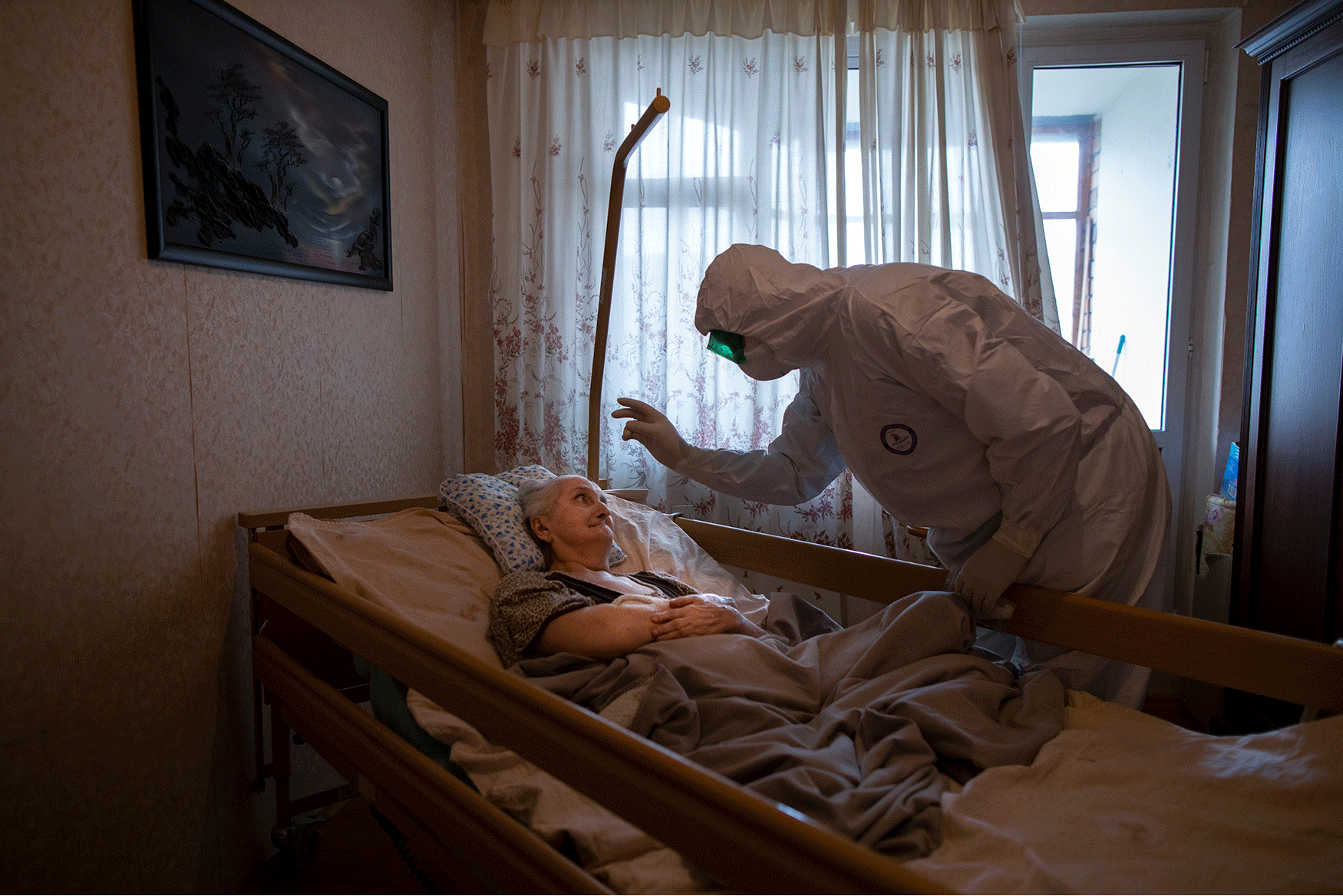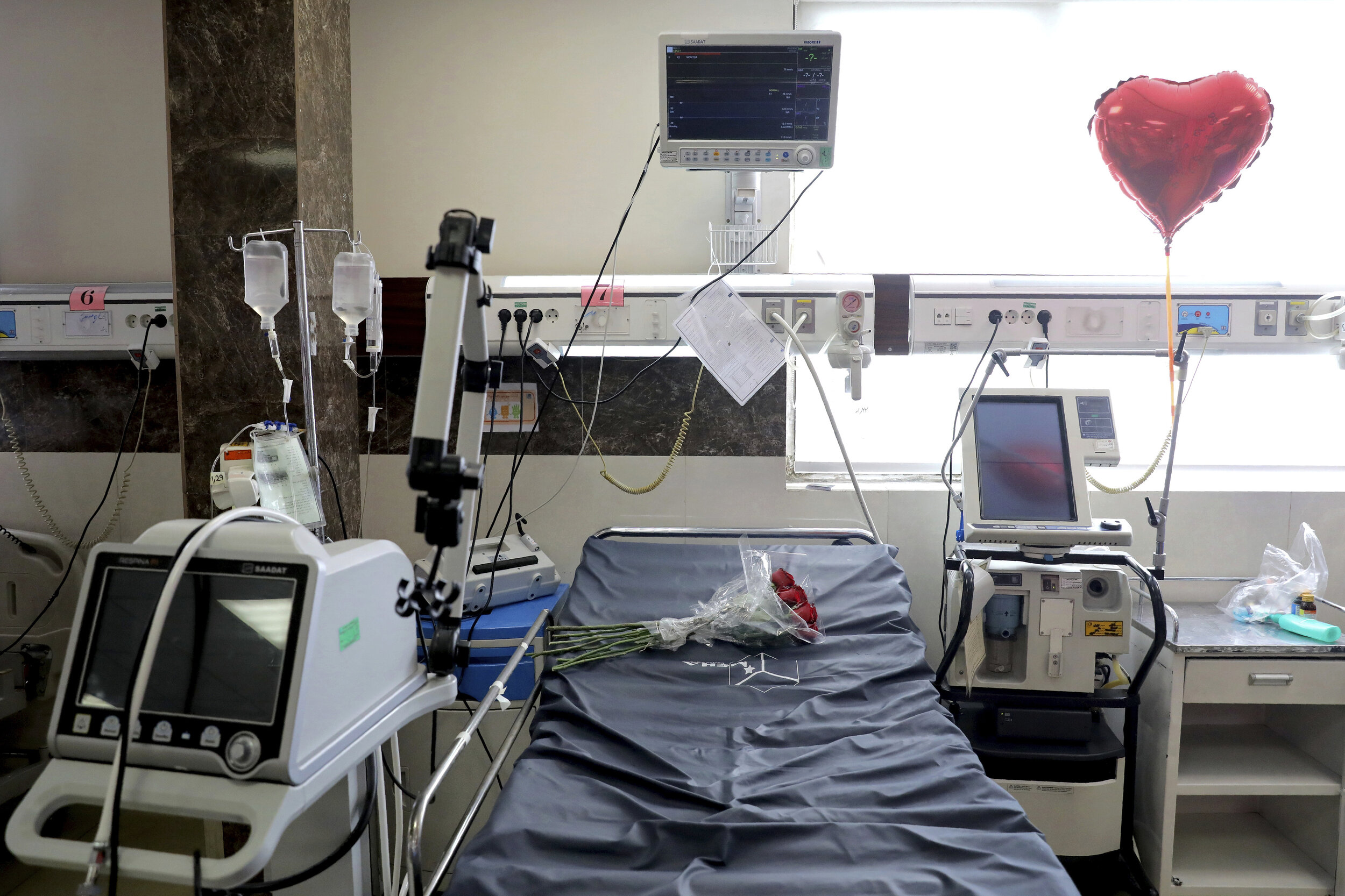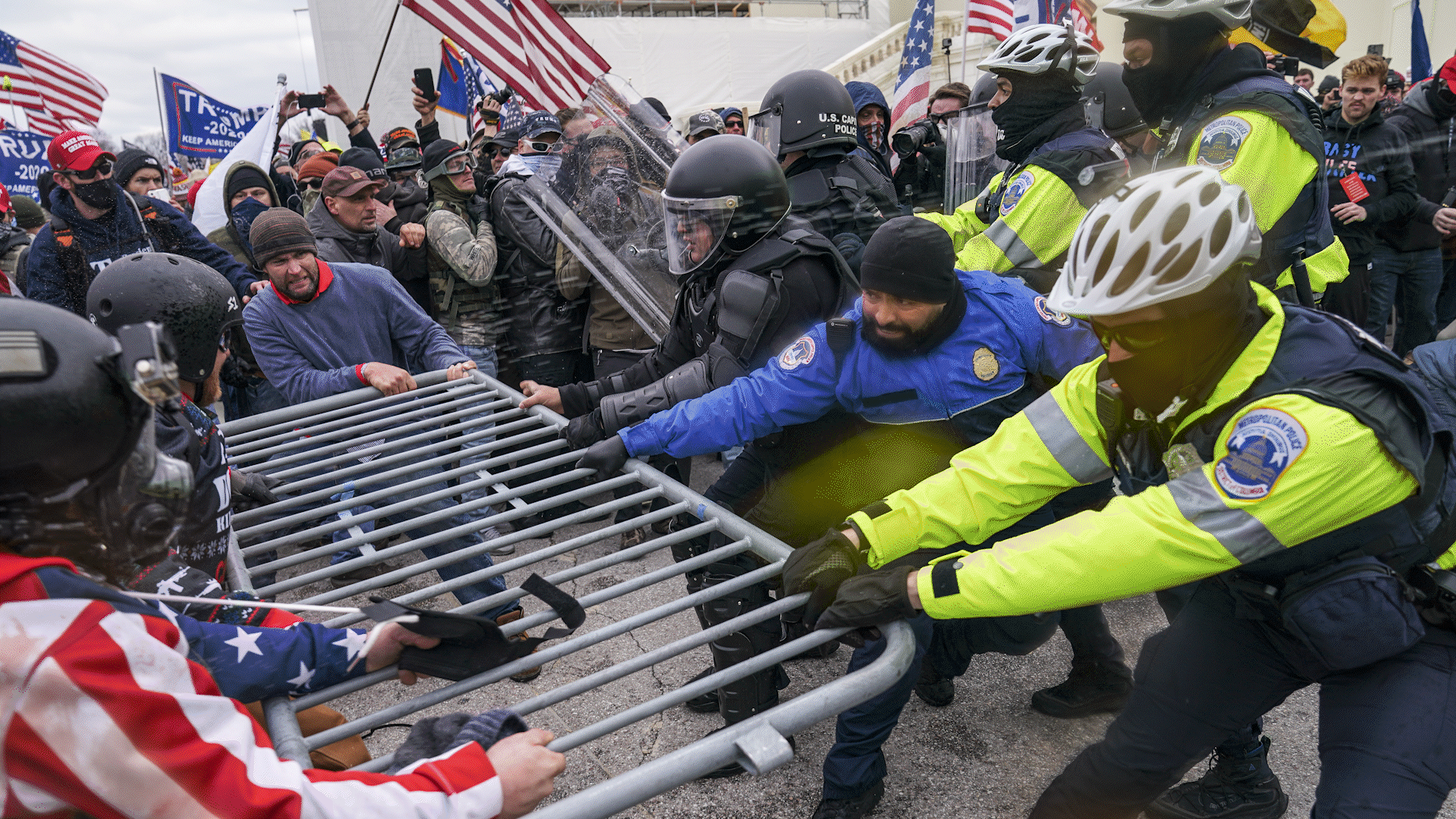Photographers reflect on single shot of pandemic

The images show the intimacy of husbands and wives saying goodbye for the last time, or reuniting after months apart. They honor the courage of nurses, funeral workers and clerics who risked their own health to do their jobs. They witness life slipping away, and being snatched back from death.
To mark the milestone of 3 million COVID-19 deaths worldwide, The Associated Press asked 15 photographers in 13 countries to pick the single image they shot that had the greatest impact, and explain why.
Their selections document the staggering human toll as COVID-19 robbed people of their lives, basic freedoms and day-to-day routines over the past year. But their reflections tell a deeper story, guiding the viewer to see and understand a once-in-a-century pandemic through the eyes of people who had the privilege and horror of witnessing it first-hand.
Just like their subjects, the AP photographers were terrified they might get infected and bring the virus home. Just like their subjects, they remain haunted by what they saw. Just like their subjects, they found moments of hope.
Father Vasily Gelevan, a Russian Orthodox priest, blesses Lyudmila Polyak, 86, who is believed to be suffering from COVID-19, at her apartment in Moscow, June 1, 2020. Associated Press photographer Alexander Zemlianichenko says this of the image: “I feel it’s both very intimate and also deeply symbolic, an image of empathy and self-denial in the face of mortal danger.” He says taking the photo was “also very important for me on a personal level, an experience that transformed me, helping overcome my own fear” of the virus. (AP Photo/Alexander Zemlianichenko)
Alexander Zemlianichenko still stays in touch with the Russian Orthodox priest who made house calls to bless the sick and dying in Moscow, saying accompanying him was “an experience that transformed me, helping overcome my own fear” of the virus.
“It’s both very intimate and deeply symbolic,” he said of his photo of the priest bending over an elderly COVID-19 patient in Moscow, “an image of empathy and self-denial in the face of mortal danger.”
Natacha Pisarenko in Buenos Aires allowed herself to join the laughter when Blanca Ortiz threw her arms up in victory after she beat COVID-19 at age 84 and was told she could go home from the hospital.
Blanca Ortiz, 84, celebrates after learning that she will be dismissed from the Eurnekian Ezeiza Hospital, on the outskirts of Buenos Aires, Argentina, Thursday, Aug. 13, 2020, several weeks after being admitted with COVID-19. Photographer Natacha Pisarenko said the moment was one of the few she witnessed in months of covering COVID-19 in which doctors and nurses allowed themselves to feel joy. “The moment made all of us in the room with her laugh and feel hopeful again,” Pisarenko said. “It was the brightest moment for me while covering such a heavy story.” (AP Photo/Natacha Pisarenko)
But Ebrahim Noroozi, AP’s Iran-based photographer, remembered he was so grief-struck that he couldn’t even pick up his camera to shoot the three volunteer clerics as they washed the body of a 59-year-old COVID-19 patient and prepared him for burial in December.
The scene momentarily paralyzed Noroozi: the clerics in dark rubber hazmat suits and bright pink and yellow gloves working behind the steamed-up windows of the cemetery preparation room, one of them standing on the table over the dead man with a bucket, washing his naked body.
Hassan Khabir, 31, left, Ali Rahimi 53, center, and Mohammad Hossein Khoshnazar, 18, right, volunteer clerics wearing protective clothing, prepare the body of a 59-year-old man who died from COVID-19 for burial on the outskirts of the city of Ghaemshahr, in northern Iran, Dec. 19, 2020. Associated Press photographer Ebrahim Noroozi says of the image: “I was filled with so much grief and sorrow; seeing the body of that dead man in such a cold and dark room that I could not even raise my camera to take a picture” at first. “But the devotion and sacrifice of the three volunteers,” who have buried some 500 bodies, “are the rays of hope ... We should still stay hopeful.” (AP Photo/Ebrahim Noroozi)
Noroozi said he was finally able to shoot after being inspired by “the devotion and sacrifice” of the three volunteers, who along with friends had buried 500 dead in and around Ghaemshahr, in northern Iran. They worked when even the victims’ own relatives stayed away from funerals for fear of contagion.
“You wonder if there are any better creatures than humans,” Noroozi said of his subjects.
Brazil photographer Felipe Dana had been on assignment in Spain early on in the pandemic when he was recalled home to document the start of Brazil’s deadly surge, which was taking a huge toll in Manaus, the capital of Amazonas state.
Dana was covering Manaus funeral workers as they buried the dead in mass graves when the workers were called to pick up the body of a suspected COVID-19 victim by boat from a river village outside the capital.
SOS Funeral workers transport by boat a coffin carrying the body of an 86-year-old woman who lived by the Negro River and is suspected to have died of COVID-19, near Manaus, Brazil, May 14, 2020. Associated Press photographer Felipe Dana says this of shooting the photo: “I’ll never forget the scene of the funeral service workers wearing full hazmat suits, navigating along the Negro River as the sun disappeared in the horizon. It was the moment I realized how the virus had spread everywhere.” (AP Photo/Felipe Dana)
Dana followed them in a rental boat and said the scene remains with him today: Funeral workers in white protective gear navigating the Negro River deep into the Amazonian jungle to get the corpse and bring it back to Manaus for burial.
“It was the moment I realized how the virus had spread everywhere,” Dana said.
Some of the selected images document how life changed even for those not infected by the virus but very much affected by it. Rome photographer Alessandra Tarantino shot a portrait of a circus worker all done up and ready to perform — for no one. The circus had come to town and the Big Top tent was up, but Italy had just gone into lockdown and all performances were canceled.
“It’s hard to dance without music,” Tarantino mused of her subject’s empty, dejected gaze.
Otilia Maria Martinez Dos Santos, an artist of Portuguese origin, poses for a portrait at the Rony Roller circus, parked in the outskirts of Rome, April 18, 2020. Photographer Alessandra Tarantino said she came up with the idea to shoot circus workers after growing frustrated and bored with the postcard-like shots of an empty Rome during lockdown. The shot was taken between poses, with the swing seemingly attached to the sky. “Her empty gaze, lost in the void, deeply affected me. It’s hard to dance without the music,” Tarantino said. (AP Photo/Alessandra Tarantino)
Ariana Cubillos chose an image of a Venezuelan police roundup of men who had violated a COVID-19 curfew in Caracas, noting the paradox that the men were facing possible exposure by being packed into a police van, “breaking the very social distancing rules authorities put in place.”
New Delhi photographer Manish Swarup said his photo of a young girl quarantined in a school epitomized the sense of powerlessness and distress children around the world experienced during lockdown. But Swarup also saw a sign that the child’s spirit remained free: She had doodled a picture of a flower on her palm.
A daughter of a migrant laborer who has been quarantined with her parents at a government school waits for her father to return with food packets in New Delhi, India, March 31, 2020. Photographer Manish Swarup said the girl’s forlorn look and confinement behind the bars of the school epitomized the imprisonment people around the world felt being cooped up at home. “It encapsulates the widespread distress caused by the lockdown, through the eyes of a child, whose life had ground to a halt,” he said. (AP Photo/Manish Swarup)
It has been nine months since Jae C. Hong photographed Romelia Navarro, as she embraced her husband, Antonio, through a sheath and face shield at the St. Jude Medical Center in Fullerton, California.
Hong was in the hospital room with the family’s consent, allowed to document one of the most intimate and difficult moments of their lives: saying goodbye as Antonio succumbed to COVID-19.
“It was the first time in my career and in my life that I watched someone die,” Hong said. He said the image of Navarro hugging her husband for the last time was important to include, a reminder of the vicious power of this “unforgiving coronavirus.”
Romelia Navarro, 64, weeps while hugging her husband, Antonio, in his final moments in a COVID-19 unit at St. Jude Medical Center in Fullerton, Calif., July 31, 2020. Photographer Jae C. Hong said even though he had the family’s consent to be there, he struggled to shoot the intimate scene, feeling uneasy to even pick up his camera and document the end of someone’s life. “Capturing someone else’s painful emotion never gets easier,” Hong said. “What I saw that day still haunts me from time to time.” (AP Photo/Jae C. Hong)
New York hospitals weren’t so accommodating to visual journalists. At the start of the city’s surge, journalists were barred from hospitals, refused access inside wards and harassed by security guards outside when they photographed bodies being loaded into refrigerated trucks nearby.
Hospital administrators cited patient privacy, but doctors and nurses wanted to get the word out about the dangers of COVID-19 and posted images of their wards on social media. “Folks may have taken COVID-19 more seriously had they seen the truth,” said New York photographer John Minchillo.
Minchillo finally gained access to the emergency room at a hospital in Yonkers, and documented a team of doctors and nurses using a defibrillator on a COVID-19 patient who had gone into cardiac arrest. Minchillo marveled at the dedication of the exhausted medical team, who saved the man after multiple rounds of defibrillation and CPR.
“This is the only image I’ve seen of a COVID-19 patient being brought back to life,” Minchillo said. “I am not naive enough to believe that it would resonate with the world, but I am grateful to have been there.”
Nurses and doctors clear themselves before defibrillating a patient who tested positive for COVID-19 and suddenly went "Code 99," or into cardiac arrest, in Yonkers, N.Y., April 20, 2020. The emergency room team successfully revived the patient. Associated Press photographer John Minchillo says of witnessing their heroic efforts: “Seeing the medical team risk death to save the life of a stranger, knowing the air surrounding us was teeming with particles from intubated patients' lungs, left me grateful for good people in this world. My respect for these New Yorkers is boundless.” (AP Photo/John Minchillo)
A child wearing a mask rests along the Yangtze River on April 5, 2020, in Wuhan in central China's Hubei province just days before the lifting of the city’s 76-day coronavirus lockdown. Associated Press photographer Ng Han Guan says of the photo: "Personally the photo summed up my feelings being in the city which was unceremoniously shut down and residents forced into a comatose state of inactivity that somehow became normalized.” Though the riverbank scene is Idyllic, he says, “in the background a slumbering city skyline is ready to hum back to life.” (AP Photo/Ng Han Guan)
Agustina Canamero, 81, and Pascual Pérez, 84, hug and kiss through a plastic film screen to avoid contracting the new coronavirus at a nursing home in Barcelona, Spain, June 22, 2020. Associated Press photographer Emilio Morenatti says this of the image: “I couldn’t help feeling emotional myself while I was shooting, and I realized that such an eternal moment symbolized something more than a simple meeting. The plastic kept the virus but not the love away.” (AP Photo/Emilio Morenatti)
South African National Defense Forces patrol the Men's Hostel in the densely populated Alexandra township east of Johannesburg, Saturday, March 28, 2020, enforcing a strict lockdown in an effort to control the spread of the coronavirus. Photographer Jerome Delay said the scene reminded him of South Africa before apartheid ended in 1994, with the army raiding the hostel not looking for guns but enforcing a strict lockdown that included a ban on the use of cigarettes and alcohol. He says he still hears the men, packed six to a room, shouting down the halls: “If we can’t go out and can’t work, we can’t eat.” (AP Photo/Jerome Delay)
Piedrangel funeral home workers Luis Zerpa, Luis Brito, center, and Jhoan Faneite, right, from Venezuela, carry the body of Marcos Espinoza, 51, who died from coronavirus in his precarious house in a poor neighborhood in Pachacamac on the outskirts of Lima, Peru, on May 8, 2020. Photographer Rodrigo Abd said the image encapsulates the injustices that the pandemic exposed: the plight of Venezuelan migrant funeral workers doing a job to survive despite the risks; the high mortality rate among Peru’s poorest and the harshness of the desert landscape around Lima, where over 10 million people live without water or basic services. “I will never forget this image for all that it represents,” Abd said. (AP Photo/Rodrigo Abd)
Men who were detained for not complying with COVID-19 regulations by breaking curfew or attending block parties, are transported in a police van, in the Petare neighborhood of Caracas, Venezuela on Aug. 8, 2020. Associated Press photographer Ariana Cubillos says the image “made me realize COVID-19 has caged us and taken away our freedom of movement. It struck me as ironic that the same authorities enforcing the curfew were putting these men at risk of contagion by breaking the very social distancing rules authorities put in place.” (AP Photo/Ariana Cubillos)
Holocaust survivor Yehoshua Datsinger places tefillin on his arm above the Auschwitz concentration camp identification number tattoo, during morning prayer at a synagogue limited to 20 people during lockdown, in Bnei Brak, Israel, Monday, Sept. 21, 2020. Photographer Oded Balilty said he was struck that even though older people were the most vulnerable to the coronavirus, Datsinger still went to synagogue every morning to pray. “He survived this latest war as well,” Balilty said. (AP Photo/Oded Balilty)
Cemetery workers in protective clothing bury a person at the Vila Formosa cemetery in Sao Paulo, Brazil, Wednesday, April 1, 2020. Photographer Andre Penner said he was initially afraid of covering funerals because he feared he might get infected and bring the virus home to his family, so he used a drone. The effect though was two-fold: It kept him at a safe distance, but it also showed the vast scope of the burial field _ a reality that President Jair Bolsonaro denied when he appeared live on social media to call the photograph “fake news.” (AP Photo/Andre Penner)
Text from AP News story, AP PHOTOS: Photographers reflect on single shot of pandemic, by Nicole Winfield






